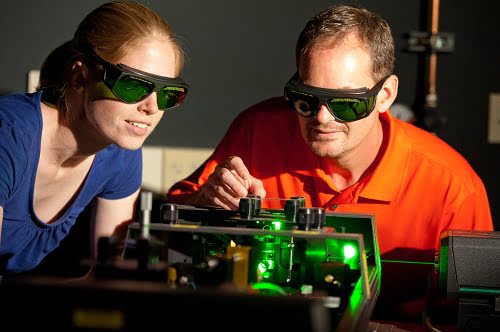ANDERSON, S.C., July 31, 2017 — The military already has a few lasers in its arsenal it's been testing to shoot down drones and incoming missiles. Now, the Department of Defense has employed the help of two Clemson University researchers to help build and design a high-energy industrial laser that could be used as a weapon on the battlefield as well.

Professor John Ballato and student tuning a laser used in this research. Courtesy of John Ballato / Clemson University.
Researchers John Ballato and Lin Zhu are working on two different methods that complement each other in hopes of improving the beam quality of high-power diode lasers for military and industrial applications. Ballato’s research focuses on the optical fiber that channels the light. Specifically, he’s trying to find materials that will not decrease the laser’s power. Zhu is focusing on the diodes that work to convert electricity to light as he looks to construct a powerful light beam that goes in one direction.
While there has been much speculation comparing their work to that of something out of “Star Wars,” Ballato told Photonics Media that’s not exactly the case.
“It’s not really a ‘Star Wars’ type laser; that's more media hype than anything,” he said. “But, it is true that both the military and the manufacturing industry is interested in developing high-power lasers.”
Ballato’s part of the project is to enhance the performance of the optical fiber — the gain medium — and Lin’s is to make the pump more efficient. Both are at the proof-of-concept level.
“We have made optical fibers that exhibit the basic properties we are interested in and will now further optimize them to the level needed for next-generation high-power laser systems,” said Ballato.

A modified chemical vapor deposition (MCVD) lathe at Clemson University used to make the glass preforms that are subsequently drawn into optical fiber. Courtesy of John Ballato / Clemson University.
While the two projects are separate, both researchers see them coming together to provide a more efficient and higher-power fiber-based laser.
“We believe that these high-power laser diodes with good beam quality will be important for the next generation of high-power laser systems," said Zhu.
Industry uses such lasers for cutting, welding and machining and the military uses such directed energy systems for combating various threats like drones and missiles. The Clemson researchers see their efforts spearheading advances in manufacturing and security.
Much of Ballato and Zhu’s research is based out of the Center for Optical Materials Science and Engineering Technologies (COMSET) at Clemson’s Advanced Materials Research Laboratory, which has maintained a relationship with the military and Department of Defense through two wars.
For Ballato, his work with optics and his partnership with the DoD go hand in hand.
“I've been making and studying optical fiber for 27 years now and I never cease to be amazed by what they can do or be used for,” he said. “This project is especially meaningful to me since my father spent his 50+ year career as a U.S. Army scientist, so anything I can do to support our troops is like paying it back to me."
Combined Ballato and Zhu have been awarded $3.2 million from the defense department to further their research and advance military laser weaponry.